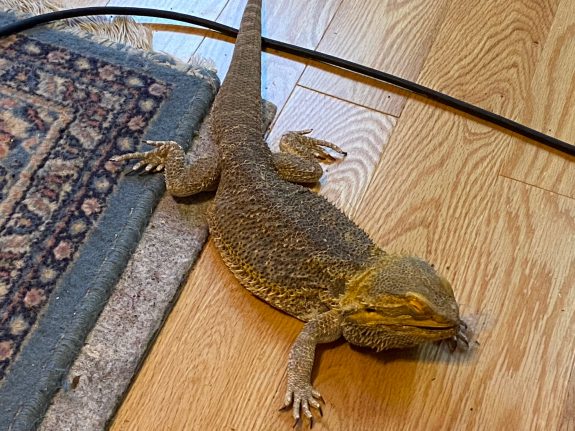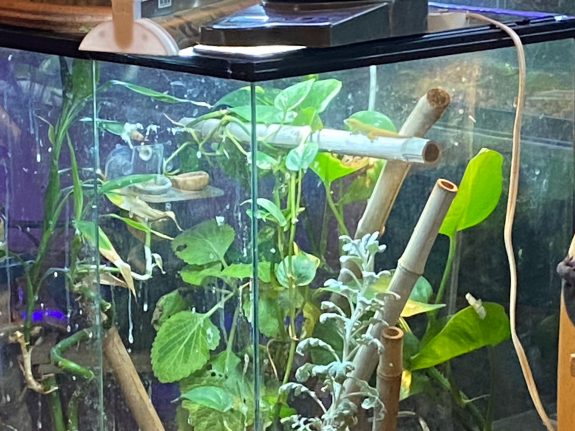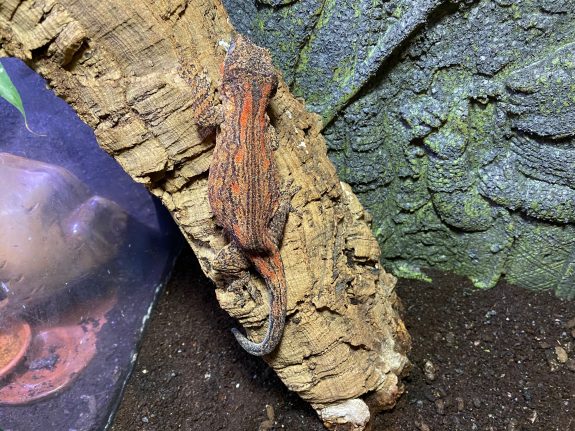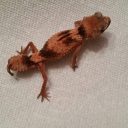Ideally we’ll own all of our geckos for many years. They’ll live comfortable, happy lives, and one day, perhaps at the advanced age of 20 or more, they just won’t wake up. We’ll miss them, but we’ll be satisfied that they had a long and happy life. Of course, it doesn’t usually work out this way. Our geckos become ill, get injured, pass away for unknown reasons, or sometimes get older and begin to fail in upsetting ways, though they continue to live. It’s not something we like to think about, but it’s reality, and we often feel powerless to help them. This article contains some practical suggestions about how to do that.
You may notice that the title contains the phrase “A Personal Reflection”. As an editor, I usually prefer to keep the author’s presence out of the article except for an occasional amusing anecdote so the focus is on the information being provided. I wanted to be clear that I’m basing this article on two aspects of my personal life: As a reptile owner, I’m currently caring for an elderly bearded dragon (there were two until a few months ago) who needs a lot of assistance to maintain any kind of quality lifestyle.

In my professional life I’m a home care speech therapist for adults. Many of my patients are at the end of their lives, are contending with physical and cognitive decline and require my help to make swallowing their food and drink safe, pleasant and sustaining.
Age and Illness
Our geckos who are “not doing well” may have an illness such as gout, cryptosporidiosis or a progressive physical infirmity (such as a curved spine) that impairs their function. At the same time, they may not be in pain and we may choose to let them live as long as they can with our assistance. Other geckos may not have a specific diagnosable illness, but are elderly and we have watched them become less efficient in their daily activities to the point where they don’t seem to be able to “care for themselves” entirely. For a reptile, “daily activities” usually include moving around, eating and drinking, shedding and defecating.
Movement
Geckos tend to be lazy creatures and they move around primarily to access food and to regulate their body temperature by shifting between warmer and cooler areas in their environment. This is why we provide a heat gradient. Some geckos may also show some curiosity about their environment and may explore new objects that are placed there. When we have a gecko who’s ill or elderly, it’s our responsibility to insure that they can access, or be assisted to access the various microclimates in their enclosures.

Arboreal diurnal geckos, such as day geckos, who spend some of their time basking at or near the top of their enclosures, may not be able to climb as readily anymore and may need the addition of a ramp, a ledge that they can be placed on (if they’ll permit handling) or a basking area that’s lower in the enclosure so they can get enough heat. The key here is knowing what your geckos’ movement habits have been previously and assisting them to approximate them when they can no longer do it themselves.
My bearded dragon was in the habit of exploring the living room and dining room outside the cage in the mornings and then alternating between his basking hammock and the floor of the cage during the rest of the day. He can no longer get into the hammock on his own, and though he can walk, if he tries to turn, his leg will often collapse under him and he’ll end up on his back and be unable to right himself. These days, in the mornings, I place him on the floor in the sun, move furniture barriers that may get in the way of his limited explorations, and check on him often to make sure he hasn’t flipped over. In the afternoons, depending on how cold or warm he feels, I rotate him between his hammock and the floor of his cage.
In the case of nocturnal terrestrial geckos it may be more difficult to determine where they need to be in the cage. Some healthy leopard geckos may spend all of their time in their warm hides, in their humid hides, or exposed in the middle of the enclosure. These habits may change due to the season or personal preference. It’s expected that an ill or elderly gecko may move around less and it’s up to us to feel how cool or warm they are and rotate them to cooler or warmer areas to insure that they don’t get too cold or too hot.
If you notice that your crested gecko or gargoyle is always at the bottom of the cage, it may be because it can no longer climb the walls of the cage. Providing easier to climb surfaces, such as cork bark or ramps that the gecko can walk up will allow the gecko to maintain its arboreal existence. It may also be necessarily to provide some ledges and place the gecko there for short periods of time if it can’t move on its own.

Shedding
Most geckos shed by rubbing themselves against a rough surface and biting or tearing at the loosening shed to get it off. An elderly or ill gecko may not have the mobility to accomplish this. When you see a gecko in advanced shed and it’s not attempting to remove the shed, you may need to “peel” the gecko out of its shed. Hold the gecko gently in one hand. Use your fingers or fingernails to pull the shed off the gecko’s body. Make sure that the shed is ready to pull away on its own; don’t try to assist shedding when you’re just noticing that the gecko is getting a little “frosty” so as not to injure the new skin. Be especially sure to remove the skin from around the eyes and the toes. Wetting the toes and using your fingernails is helpful in removing toe skin. Tweezers are often useful in removing shed from around the eyes. If shed remains near the eyes, it can get under the lid (if your gecko has lids) and irritate the eye. If shed remains on the toes it can constrict circulation to the toes. Most geckos don’t really like to be “peeled” and may struggle. Sometimes holding the gecko on your lap and putting your shirt tail over its head will convince it that it’s “hiding” and it may tolerate the process better. For geckos that can’t be handled, or where you feel that the activity will distress them to the point of them dropping their tails, you could try setting up a container with warm moist paper towels as a sort of sauna and put them in there to see if the shed will come off more easily.
Eating and drinking
Getting a gecko to eat is one of the hottest topics in gecko husbandry. Most geckos get their nutrition by hunting down moving feeders such as worms or crickets, or eating fruit nectar from a bowl. As geckos age or become ill, they have more trouble seeing and catching moving prey, and may also have less desire for food in general. If they’re not moving much, they don’t need as much food as they did previously because they’re not burning as many calories but they still do need to eat. Gecko Time has published several articles about how to help geckos eat: “My Gecko is not Eating: Why and How to Fix it”, “My Gecko Will not Eat Part 2”. These techniques may be useful in assisting your gecko to eat or hand feeding it. Fruit nectar eating geckos may need to have some of the CGD (“Crested Gecko Diet”) smeared on their noses so they can lick it off. Geckos that eat live prey may need to be held and have food pushed into their mouths. The most important thing to remember is that we are assisting them to eat, not force feeding them. My bearded dragon will currently not eat on his own. On feeding days, I have to pull open his mouth, insert the fruit, vegetable or cricket and wait for him to chew and swallow. Often he begins by chewing, swallowing and clearing his mouth, but after awhile he will just let the food sit in the back of his mouth. I have to be sure to stop when this happens or he’ll just throw up the food that’s sitting there. Be aware of when your gecko is actually chewing and swallowing its food and when the food is just sitting in its mouth. The gecko may have some “good” days and some “bad” days. Try not to worry if there’s an occasional bad day; keep the big picture in mind.
There’s been much written about an appropriate diet for a gecko. In the case of elderly or ill geckos, whatever they’ll eat is acceptable. My bearded dragon probably gets more fruit than is generally recommended because he’ll eat it more readily. At this stage in his life calories are more important than ideal nutrition. Some feeders may be easier to get into the gecko than others. Some feeders may be better tolerated by your gecko. Feed it whatever works best. If you’re concerned about supplementation, it’s always possible to dip your finger in water, then dip it in the supplement and rub some of the resulting paste onto the gecko’s mouth. Most likely it will lick the paste off and ingest the supplement.
Some insect and worm eating geckos will only ingest puree foods. There are some available commercially. A home made version, used by many gecko keepers was developed by Marcia McGuiness of Golden Gate Geckos and can be found here on her website.
Some geckos use a water dish, others lick droplets off plants or walls in their enclosures and others obtain most of the moisture they need through their food. A gecko with limited mobility will not necessarily be able to access the water bowl or droplets. You may need to drip water on their noses and let them lick the droplets. It’s also possible to use a small syringe, place the end in the mouth and squeeze a little water in. Be careful not to flood them with liquid!
Defecating
In most cases, this is the least problematic issue (so to speak). Geckos that poop in a particular area may be encouraged to move their bowels by being placed in that area, especially if can no longer get there on their own. Geckos that tend to stay in one location may also poop and pee in those places as well. Be aware of poop and pee int their resting places and clean regularly. Watch for geckos that seem to be straining to poop and provide a drop of olive oil or mineral oil on their noses for them to lick off to “grease the way”. Geckos that poop very rarely and don’t seem to be impacted may not be getting enough nutrition. Depending on the status of the gecko it may or may not be possible to get them to eat more.
Letting Go
Sometimes a gecko can’t be sustained any longer. They may not be willing to eat no matter what you do. They may be in pain, though it’s hard to tell with reptiles. Whether to let the gecko pass away in its own time or to seek vet assistance and have the gecko “put down” is a personal choice. There is information on the internet about how to euthanize the gecko yourself, which may include putting it in the freezer, or feeding it to another reptile. These methods are not recommended since it’s very likely that it will cause pain. If your gecko appears to sink into a coma, won’t eat, drink or move, even with assistance, it is OK to let it sit in its cage and pass away on its own. A gecko who appears to be uncomfortable or in pain can be taken to the vet for euthanasia ,which usually involves painless sedation and death.

The death of a pet, even one who has lived a long life is always sad and painful. It may be a little comforting to know that we have done our best to make the last stage of their lives as high quality as possible and to have eased their transitions to the best of our abilities.




Thank you for this article. In years past I had to have an elderly iguana euthanized. My current geckos are all young yet, but eventually we will get to that “elderly point”. This is helpful information to have. To those of us reading this, they are not “just reptiles,” so caring for them into their senior years is just as important as caring for them as babies.
Glad you enjoyed it. Thanks for letting me know
this is the new server
My leopard gecko is 22 years old. I never thought she would still be with me in my 40s. Her health is failing. I’ll continue to hand feed her crickets as long as she’ll take them, but she’s so weak. Thank you for this article. It helped me be more comfortable with letting her peacefully pass in her cage.
Thank you for your reply. Death is the hardest part of pet keeping. Our thoughts are with you both.